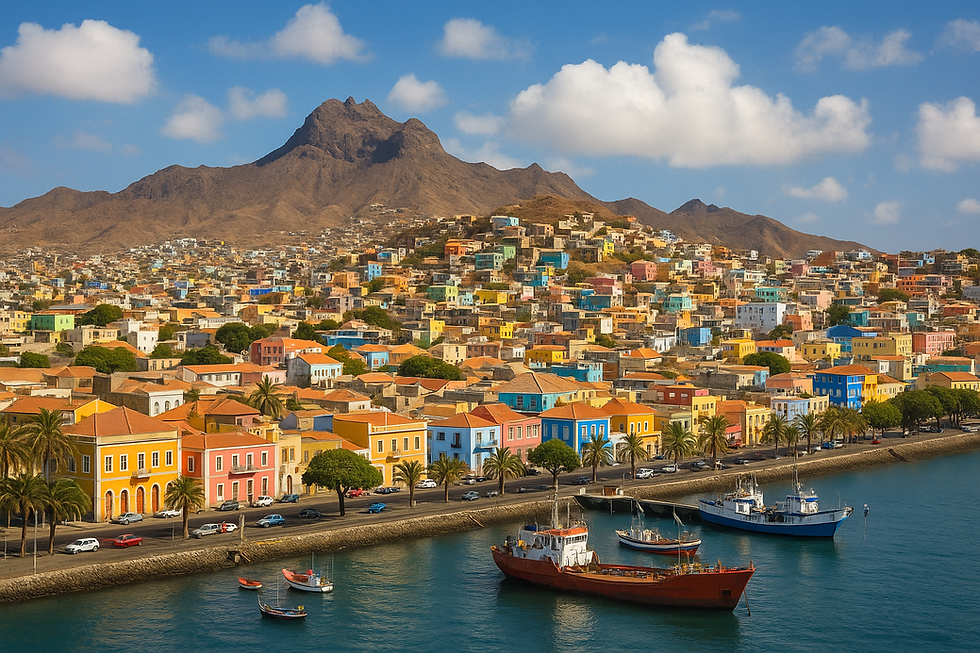Cape Verde Bets on Wind and Water to Escape Debt and Drought
- tinchichan

- 9 minutes ago
- 4 min read
Cape Verde is placing big bets on the wind, the sun, and its 700,000-strong diaspora to fund a sustainable future in a warming Atlantic. With no rivers, no oil, and little arable land, the West African archipelago is building a clean energy grid and blue economy to offset the dual risks of climate volatility and public debt.
The country is aiming for 50% renewable electricity by 2030, 100% by 2050, while piloting solar-powered desalination systems, eco-tourism models, and diaspora-backed ESG funds. The challenge? Delivering on its green ambitions while managing public debt levels above 100% of GDP and mitigating rising climate shocks—from drought to sea-level rise.

“We have no choice but to be sustainable,” says a senior finance ministry official. “For us, ESG is not a label—it’s a necessity.”
1. Macro Snapshot: Small Island, Big ESG Bets
Indicator | Value (2024 est.) |
Population | ~560,000 |
GDP (nominal) | ~$2.6 billion |
GDP per capita (nominal) | ~$4,700 |
Public debt-to-GDP | ~115% |
Renewable electricity share | ~22% |
Electrification rate | ~98% |
Climate finance need (by 2030) | ~$1.1 billion |
Remittances (% of GDP) | ~12–14% |
*Cape Verde is a lower-middle-income, service-based economy with limited natural resources but strong institutional capacity, high political stability, and a long track record of regional leadership in climate adaptation.
2. Environmental Strategy: Turning Scarcity into Strategy
Energy Transition
Electricity mix (2023):
~78% fossil fuels (imported diesel)
~22% renewables (wind, solar, small biomass)
Target: 50% renewables by 2030, 100% by 2050
Flagship project: Cabeólica Wind Farms (25 MW across 4 islands)
Solar microgrids in rural areas scaling with EU, AfDB, and UNDP support
Water Security
No permanent rivers; heavy reliance on desalination
Climate-induced drought worsening since 2017
Innovations:
Solar-powered desalination (Sal, São Vicente)
Rainwater harvesting and fog nets
Wastewater reuse pilot programs in agriculture
Blue Economy
Ocean contributes ~20% of GDP (fisheries + tourism)
Marine protected areas (MPAs) expanded
Coastal resilience projects funded by GEF, Portugal, and GCF
3. Social Performance: Diaspora, Gender Leadership, and Youth Potential
Human Development
HDI (2023): 0.662 (ECOWAS #2)
Life expectancy: ~73 years
Literacy: ~87%
Urbanization: ~70%
Unemployment: ~11% (youth unemployment ~23%)
Diaspora and Remittances
Diaspora size: ~700,000 (mostly in Portugal, U.S., Netherlands, France)
Remittances = ~$300 million/year
Government deploying Diaspora Investment Platform (DIP) to channel funds into ESG-aligned projects (solar, housing, agriculture)
Gender and Youth
Women lead ~30% of SMEs
Active in fisheries, farming cooperatives, eco-tourism
Youth under 30 = ~60% of population
National programs in green skills, digital literacy, and climate entrepreneurship expanding
4. Governance & ESG Regulation: Strong Institutions, Emerging Frameworks
Political Stability
Multiparty democracy with peaceful transitions
Consistently ranks in top 3 on Mo Ibrahim Index for Governance in Africa
Low corruption (TI Rank 2023: 35/180, highest in West Africa)
ESG Regulation
Climate Law (2022) outlines adaptation and mitigation mandates
Environmental Impact Assessments (EIAs) required for major projects
Nationally Determined Contribution (NDC) targets:
35% emissions reduction by 2030 (conditional)
100% renewables by 2050
Lacks mandatory ESG reporting, but voluntary frameworks growing in tourism, energy, and banking
5. Green & Blue Finance: Blended Capital in Action
Climate Finance Inflows
Source | Program Focus | Amount |
Green Climate Fund | Coastal adaptation, water, energy | $54M+ |
World Bank | Fiscal resilience, energy access | $60M+ |
EU/AfDB | Green infrastructure, smart grids | $80M+ |
GEF | Biodiversity, waste, conservation | $20M+ |
*Cape Verde is exploring:
Sovereign green bond (first issuance targeted in 2025)
Blue bond feasibility study in collaboration with Portugal and AfDB
Diaspora ESG bonds for solar, eco-tourism, and sustainable housing
6. ESG Innovation: Local Models, Global Relevance
Case Study 1: Cabeólica Wind Energy PPP
25.5 MW across four islands
Reduced diesel imports by ~15%
First large-scale wind PPP in Sub-Saharan Africa
ESG impact: emissions avoided, jobs created, energy cost savings
Case Study 2: Solar-Powered Desalination (Sal Island)
100% solar energy-powered
Cuts fossil fuel imports and reduces water costs
Community-managed with EU co-finance
Case Study 3: Mindelo Blue Economy Hub
Combines coral reef restoration, marine research, and eco-tourism
Funded by GEF and diaspora trust fund
Metrics: reef health, job creation, biodiversity index
7. Regional ESG Positioning: A West African Outlier
ESG Metric | Cape Verde | Senegal | Ghana | Mauritius |
GHG per capita (tCO₂e) | ~1.3 | ~0.6 | ~0.9 | ~3.6 |
Renewable electricity (%) | ~22% | ~31% | ~35% | ~20% |
Public debt-to-GDP | ~115% | ~74% | ~82% | ~74% |
TI Corruption Rank (2023) | 35/180 | 72/180 | 70/180 | 57/180 |
Sovereign green bond | In design | Yes | Yes | Yes |
*Cape Verde punches above its weight on climate readiness and governance, but its fiscal position and infrastructure gaps remain constraints.
8. ESG Risks and Investment Signals
Key Risks
Debt vulnerability limits fiscal room for green investment
High exposure to climate shocks (drought, SLR, hurricanes)
Overdependence on external aid and remittances
Fragile agriculture and tourism sectors vulnerable to weather volatility
Key Opportunities
First-mover potential in sovereign blue or diaspora ESG bonds
Scalable models in solar-powered desalination and off-grid renewables
Positioning as ESG finance hub for African SIDS and Lusophone countries
Expansion of marine spatial planning and coral protection zones
Bottom Line: ESG-Forward, Debt-Heavy, Innovation-Ready
Cape Verde is not waiting for the global climate finance system to fix itself. It’s crafting its own ESG roadmap—solar panel by solar panel, cooperative by cooperative, diaspora dollar by diaspora dollar.
For investors seeking frontier-market ESG exposure with political stability, energy transition upside, and blue economy innovation, Cape Verde offers a compelling case. But the risks—especially on debt management and climate volatility—are real.
In the Atlantic’s warming waters, Cape Verde is testing whether small islands can lead big transitions.



Comments